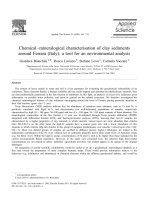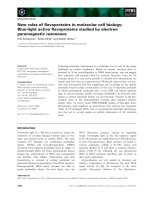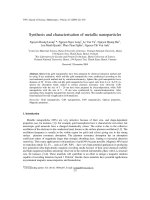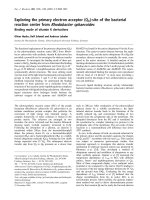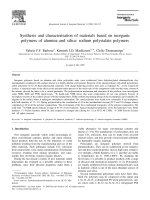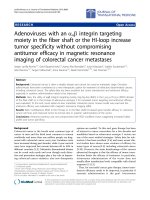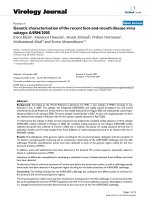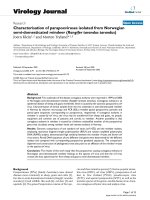Electron spin resonance characterisation of sedimentary quartz of different grain sizes
Bạn đang xem bản rút gọn của tài liệu. Xem và tải ngay bản đầy đủ của tài liệu tại đây (1.7 MB, 7 trang )
Radiation Measurements 120 (2018) 59–65
Contents lists available at ScienceDirect
Radiation Measurements
journal homepage: www.elsevier.com/locate/radmeas
Electron spin resonance characterisation of sedimentary quartz of different
grain sizes
T
A. Timar-Gabora,b,∗
a
b
Interdisciplinary Research Institute on Bio-Nano-Science, Babeş-Bolyai University, Cluj-Napoca, Romania
Faculty of Environmental Sciences and Engineering, Babeş-Bolyai University, Cluj-Napoca, Romania
A R T I C LE I N FO
A B S T R A C T
Keywords:
Quartz
Electron spin resonance (ESR)
Al-hole centre
Ti-centres
E1′ centre
Peroxy centre
Grain size
Different optically stimulated luminescence (OSL) single aliquot regenerative (SAR) saturation characteristics have
been previously reported for quartz of diverse grain sizes. This preliminary electron spin resonance (ESR) study
documents on paramagnetic signals in natural sedimentary quartz extracts of different grain sizes (4–11 μm, 63–90 μm,
90–125 μm, 125–180 μm, 180–250 μm) extracted from loess and sand samples that are amendable to OSL and ESR
dating. Spectra recorded at room temperature and low power (< 1 mW) are dominated by the E1’ centre, whose
intensity in natural samples was found to decreases with increasing grain size. The signature of titanium centre could
not be detected in fine (4–11 μm) quartz. For coarse fractions (> 63 μm) titanium-lithium [TiO4/Li+]0 signals increase
with increasing grain size. Aluminium-hole ([AlO4]0) signals are observed in all natural and laboratory irradiated
investigated samples when spectra are recorded at low temperature (90 K). The intensity of these signals appears to
decrease with increasing grain size, however, room temperature measurements show that these signals are highly
interfered by a variety of signals tentatively attributed to peroxy (g ≈ 2.007 and g ≈ 2.004) with significantly higher
intensities in fine grains (4–11 μm). A decrease of their intensity is reported when grain size increases and partial
evidence that these defects are preferentially located in damaged regions of the grains is presented. A dose dependent
paramagnetic signal at g ≈ 2.011 was detected only in 4–11 μm quartz. The stronger signature of the [TiO4/Li+]0
signals in larger grains coupled with the weaker signals of peroxy signals interfering with [AlO4]0 signal measurement
is suggesting that coarser fractions should be preferred for conventional ESR dating using aluminium-hole and titanium
signals. The understanding of the implication of these defects in OSL dating alongside with their concentration dependency on grain size requires further investigations.
1. Introduction
By analysing different grain sizes of quartz from different sedimentary
contexts around the world it was concluded that the saturation characteristics of single aliquot regenerative (SAR) optically stimulated luminescence
(OSL) signals are anticorrelated with grain diameter (Timar-Gabor et al.,
2017). While significantly higher saturation characteristics are reported for
the fine (4–11 μm) quartz fraction compared to coarser fractions (> 63 μm),
there is increasing evidence that laboratory saturation at higher doses does
not provide a corresponding extended age range in luminescence dating
(Timar-Gabor and Wintle, 2013; Timar-Gabor et al., 2017). Saturation of
luminescence signals in quartz can be dictated by various physical processes
related to both charge trapping and recombination. However, defects giving
rise to luminescence (thermoluminescence (TL) and optically stimulated
luminescence (OSL)) in quartz have not yet been unambiguously identified.
Electron spin resonance is one of the few methods sensitive enough to
monitor defects in quartz. It well known that a large number of
∗
paramagnetic defects are present in quartz such as E′- centres, peroxy
centres and oxygen hole centres, [H3O4]0, [AlO4]0, [AlO4/H+]+, [GeO4/
Li+]0, [TiO4/M+]0 (where M+ denotes an alkali metal or hydrogen ion),
etc. (Preusser et al., 2009). These ubiquitous defects can be involved
through different mechanisms in optically stimulated luminescence as
electron traps, recombination centres or competitors for trapping or recombination.
Al is always present in quartz, and is giving rise to [AlO4/M+]0 (where
+
M denotes an alkali metal or hydrogen ion), and [AlO4]0, respectively
(Malik et al., 1981). Studies on radiation-induced ionic conductivity of
quartz (Weil, 1984; Martini et al., 1986) showed that irradiation at room
temperature leads to the dissociation of [AlO4/M+]0 resulting in the formation of [AlO4/H+]0 and [AlO4 ]0 centres. In addition, Mondragon et al.
(1988) suggested that the relative proportion of [AlO4/H+]0 and [AlO4]0
might be dose-rate dependent. While studies performed in the late 1980s
(e.g. McKeever, 1991) suggested that electron-hole recombination at
[AlO4]0 sites yields the TL emissions near 470 nm, whereas recombination
Interdisciplinary Research Institute on Bio-Nano-Sciences, Babeş-Bolyai University, Treboniu Laurean 42, 400271, Cluj-Napoca, Romania.
E-mail address:
/>Received 5 December 2017; Received in revised form 15 May 2018; Accepted 26 June 2018
Available online 28 June 2018
1350-4487/ © 2018 The Author. Published by Elsevier Ltd. This is an open access article under the CC BY-NC-ND license
( />
Radiation Measurements 120 (2018) 59–65
A. Timar-Gabor
at the [H3O4]0 site yields the 380 nm TL emissions, more recent studies
correlate [AlO4]0 to the luminescence centres involved in the production of
OSL (emissions around 380 nm) (Martini et al., 2009, 2012 a,b, 2014).
[AlO4]0 signal is also frequently used in ESR dating of sediments (Tissoux
et al., 2010, Bahain et al., 2012, Moreno et al., 2012, Voinchet et al., 2013,
Tsukamoto et al., 2015 etc.).
E1’ centre is a paramagnetic oxygen vacancy formed from a neutral
oxygen vacancy which traps an electronic hole. It was proposed that
these holes can be released upon heating by Al-hole defects (Rudra and
Fowler, 1987). Experimental results (Woda et al., 2002, Schilles et al.,
2001) support the idea that this centre may act as a non-radiative recombination centre acting in competition with the emission bands in
the near UV and visible region.
Ti4+ may substitute Si4+ in quartz with no charge compensation,
creating [TiO4]0, the precursor for the Ti centre (Weil, 1984). Upon room
temperature irradiation, Ti4+ may trap an electron together with an alkali ion
M+ for charge compensation, forming [TiO4/M+]0, where M+ can be either
Li+, H+ or Na+ (Toyoda, 2015). While signals form Ti-centres received
considerable attention lately in ESR dating of sediments (Beerten et al., 2006;
Duval and Guilarte, 2015; Duval et al., 2017), to our knowledge, their possible involvement in OSL production has been less documented.
ESR signals of the Ge centres are observed usually in irradiated quartz
samples (Toyoda, 2015). From the precursor [GeO4]0, the paramagnetic
defect [GeO4]- is formed through electron trapping. This centre is not stable
at room temperature, and recent studies present strong evidence that this
defect can be correlated to the 110 °C TL peak electron trap (Vaccaro et al.,
2017). [GeO4/M+]0 centres, and most notably [GeO4/Li+]0 have a higher
degree of thermal stability (Vaccaro et al., 2017).
Oxygen –associated trapped hole centres have been identified in silica
and denoted “dry OHC” and “wet OHC” according to the OH− content of
the material (Stapelbroek et al., 1979). Dry OHC (Friebele et al., 1979) is an
oxygen interstitial in the form of ≡Si-O-O∙ (where “≡” represents the three
Si-O bonds and “∙” represents an unpaired electron), and is referred to as
“peroxy centre” by Ikeya (1993), a nomenclature further used here. Wet
OHC is an oxygen hole in form of ≡Si-O∙, denoted in the same nomenclature as non-bonding oxygen hole centre (NBOHC), while OHC term is
used to denote a dose dependent signal, sometimes ascribed to the ozonide
radical (O3−) (Ikeya, 1993). Although their existence in quartz was proposed decades ago, their characteristics in crystalline quartz and their implication for dating has been less documented than the other signals described above. However, a combination of five peroxy signals was identified
in natural quartz that has not been subjected to additional artificial irradiation by Botis et al. (2005) and their structure has been further investigated by Nilges et al. (2009) and Pan and Hu (2009).
In this study we complement previous luminescence investigations with
electron spin resonance (ESR) investigations on different grain sizes
(4–11 μm, 63–90 μm, 90–125 μm, 125–180 μm, 180–250 μm) of sedimentary quartz. A dependence of the most important paramagnetic defects
listed above as function of grain size is presented allowing for some preliminary conclusions regarding their implication in dating to be drawn.
2. Materials and methods
2.1. Samples
Sedimentary quartz samples of different grain sizes extracted mostly
from loess have been investigated. Quartz has been extracted according to
standard OSL preparation techniques under subdued red light (see further
information in the supplementary file). During ESR measurements the
samples have not been exposed to direct sunlight and their exposure to
weak natural light was restricted to minimum. The selection of samples was
based on: (i) the availability of sufficient material for ESR investigation, (ii)
the high purity of the quartz extracts as confirmed by routine tests in OSL
dating as well as by scanning electron microscopy imaging coupled with
chemical analysis of local area by energy dispersive X-ray spectroscopy
(EDX) using a FEI Quanta 3D FEG dual beam microscope (see Fig. S1), (iii)
(caption on next page)
60
Radiation Measurements 120 (2018) 59–65
A. Timar-Gabor
Fig. 1. Examples of Al-hole (a), titanium (b) spectra recorded at 90 K and E1′
signals (c) measured at room temperature for 125–180 μm quartz (sample STY
1.10). For this particular sample a dose of 100 Gy was given on top of the
naturally accrued dose. Measurement parameters are given in Section 2.
the excellent behavior of the samples in the single aliquot regeneration
protocol, with no aliquot rejected due to poor recycling, IR depletion or
recuperation (Murray and Wintle, 2003).
Sample Rox 1.14 originates from Roxolany loess palaeosol section,
Southern Ukraine and was collected below the Brunhes/Matuyama polarity
transition. An electron spin resonance age of over 1 Ma was obtained for
this sample using a multiple centre (Al and Ti) approach (Duval et al.,
2017). This result, along with optically stimulated investigations using both
the standard single aliquot regenerative (SAR) multi grain OSL procedure as
well as single grain investigations are presented in detail in Anechitei-Deacu
et al., this issue. Sample Rox 1.9 is quartz extracted from a loess sample
collected just above the Eemian soil (MIS 5e) from the same section. Quartz
samples Sty 1.10 and Sty 2.4, were extracted from samples collected from
Stayky loess palaeosol section, Northern Ukraine. For Sty 2.4 equivalent
doses of 69.7 ± 0.8 Gy and 59.7 ± 1.5 Gy were obtained using standard
SAR-OSL dating using 4–11 μm and 63–90 μm quartz respectively. For
sample Sty 1.10 an equivalent doses of 492 ± 30 Gy was obtained on
4–11 μm quartz, however in the case of coarse grains the natural signals
were found close (about 85%) to SAR laboratory saturation. The OSL
chronology of this section as well as extended SAR-OSL dose response
curves on these samples are presented in detail in Veres at al., submitted.
For further experiments, calibration quartz (Cal Q) provided by Risø
National Laboratory (Hansen et al., 2015) was used, due to the availability
of high amounts of sample. The 180–250 μm quartz fraction was separated
from aeolian sand from Rømø, Jutland, Denmark, through conventional
sample preparation techniques (Hansen et al., 2015). It is important to note
that this quartz sample has only undergone physico-chemical preparation,
without the sensitisation (annealing, dosing, annealing).
2.2. Instrumentation and measurement protocols
Electron spin resonance analyses have been carried out using an X band
Bruker EMX plus spectrometer. A high sensitivity cavity (ER 4119HS Bruker
resonator) with an unloaded quality factor of 15,000 and loaded factor of
about 7800 for the investigated samples was used. Low temperature measurements were performed using a variable temperature unit. Care was
taken that all samples are centered inside the cavity and have the same
height. The mass of one sample was approximately 200 mg in the case of
coarse grains (> 63 μm) and about 120 mg in the case of fine grains, with
variations of 10%. Mass normalisation was applied for the measured signals,
where relevant. Samples have been rotated in the cavity for collecting
several spectra using a programmable goniometer. If not otherwise mentioned measurement parameters employed for recording Al-hole ([AlO4]0)
signals were: temperature of 90 K, modulation frequency 100 kHz, modulation amplitude of 1 G, 3350 G centerfield, 300 G sweep width, 120 s
sweep time, 40 ms conversion time, 40.96 ms time constant. Microwave
power was 2 mW and the sample has been rotated 3 times (every 1200) in
the cavity. A single scan per angle was carried out and the average of the
three spectra was computed. For titanium centres ([TiO4/M+]) the following measurement parameters have been used: measurement temperature 90 K, modulation frequency 100 kHz, modulation amplitude 1G,
3490 G centerfield with a 220 G sweep width, 22s sweep time, 10 s conversion time, 20.48 ms time constant. Microwave power was 10 mW and 30
scans have been performed. E1' spectra have been recorded at room temperature at an optimal power of 0.02 mW selected based on power saturation experiments. 12 rotations (every 300) have been carried out. The
modulation amplitude was 0.1 G, centerfield was set to 3360 G, the sweep
width was 20 G with a sweep time of 40 s, conversion time of 20 ms and
time constant of 20.48 ms. Measurements have generally been repeated 2–5
times at a few weeks interval in order to check the reproducibility of the
(caption on next page)
61
Radiation Measurements 120 (2018) 59–65
A. Timar-Gabor
Fig. 2. Dependece of Al-hole (a), titanium (b) E1’ (c) natural signals magnitude
as function of the grain size of quartz for the available grain sizes from samples
Rox 1.14 (squares), STY 1.10 (up triangles) Rox 1.9 (circles) and Sty 2.4 (down
triangles). Measurement parameters are given in Section 2. Mass normalisation
to a mass of 100 mg was performed for peak to peak intensities of the signals
measured as shown in Fig. 1.
we have investigated so far despite applying repeated scans or irradiating
the samples. The lack of these signals is further depicted in Fig. S4, for a fine
grained sample irradiated with 10,000 Gy.
Titanium signals intensity linearly increases with increasing grain size in
the case of coarse grains (> 63 μm). Results reporting an increase in sensitivity with increasing grain size have also been reported for fluvial sediments by Liu et al. (2015). As far as Al-hole and E1′- centres are concerned,
both their concentration seems to decrease as the grain size increases.
Larger grain sizes are characterized by lower E1′- centre concentration as
well as apparent lower Al-hole concentrations.
The differences observed between grain sizes could be attributed to the
presumably different origins of the fine and coarse quartz material, as the
fine material (4–11 μm) could originate from more distal sources. However,
it can be observed that the trend mentioned above is valid for samples of
different origins. Stayky is located on the upper Dnieper River that is only
draining the East European platform comprising very old mainly metamorphic and magmatic rocks of Proterozoic age, while Roxolany sits at the
mouth of Dniester river, that is has its origin in the Outer Carpathian
Mezozoic flysh deposits, as such the sources of the sedimentary quartz from
Sty and Rox are expected to be of different origin.
3.2. Contribution of peroxy signals to Al-hole signal measurement
It is important to note that in the case of Al-hole signal the signature
recorded for finer grains displays a different shape (Fig. 3). This was observed in the case of all samples investigated in this study and all fine grain
quartz samples investigated so far in our laboratory. For the sake of completeness Fig. S5 additionally presents a comparison of the natural signals
for sample Sty 2.4. It can be noted that the hyperfine signature is less
pronounced for the signals of fine quartz and the signal is reaching its
maximum value at g ≈ 2.008, while in the case of coarse grains for natural
signals peaks at g ≈ 2.018 as expected for typical aluminium-hole signals.
This difference can be more easily observed when comparing natural signals
to signals measured after laboratory doses are given on top of the naturally
accrued dose. After adding laboratory doses the signal of fine grains gradually increases and reaches its maximum at g ≈ 2.018 (Fig. S6).
As this observed apparent difference in shape could be attributed to
interfering signals, measurements using the same parameters as in the
case of aluminium-hole measurements but conducted at room temperature were carried out, as is well known that when measuring at
room temperature Al-hole signals can no longer be observed due to the
very short spin-lattice relaxation time of the defect. As such, if the interfering signal could be detected at room temperature, its signature
should be discernible in these room temperature spectra.
In Fig. 4 a such room temperature spectra recorded for fine
(4–11 μm) quartz are presented in comparison to spectra collected in
the same manner for coarse (90–125 μm) quartz. It can be noted that
signals at g ≈ 2.0084–2.0063 (indicated by “A” in Fig. 4 a)) and
g ≈ 2.0047–2.0022 (indicated by “B” in Fig. 4 a)) are present in both
fine and coarse quartz grains. For better visualization a comparison
between room temperature spectra and liquid nitrogen spectra for fine
(4–11 μm) and (90–125 μm) quartz respectively is presented in Fig. S7.
These signals are not increasing upon gamma irradiation as shown in
Fig. 4 b) for fine quartz and Fig. 4 c) for coarse quartz respectively. We
tentatively attribute these signals to peroxy radicals (Botis et al., 2005;
Nilges et al., 2009; Pan and Hu, 2009). The signature of these signals
ascribed to peroxy centres are visible in room temperatures spectra as
well as spectra recorded at liquid nitrogen after the samples were heated to 500 °C, a temperature for which Al-hole signals are annealed
(Toyoda and Ikeya, 1991) (see Figs. S8–S9).
Further examination of spectra recorded at room temperature reveal
the weak presences of Ge centres (Ikeya, 1993), namely [GeO4/Li+]0 at
g ≈ 1.996 both in the case of fine and coarse grains when spectra are
recorded at room temperature (Fig. 4b) and c)). Notably, only in the
case of fine (4–11 μm) quartz a dose dependent paramagnetic signal at
g ≈ 2.011 was detected. Ikeya (1993) reported such a signal (see their
Fig. 3. Dependece of Al-hole natural signals shape as function of the grain size
of quartz for sample Rox 1.14. Natural signals are represented. Measurement
parameters are given in Section 2.
system but also for quantifying average values and associated errors.
Examples of such reproducibility tests are presented in supplementary
material (Figs. S2 and S3).
Irradiations have been performed at Centre for Nuclear Technologies,
Technical University of Denmark (DTU NUTECH) using a calibrated 60Co60 gamma cell, with a dose rate of 2 Gy/s (dose rate to water) at the time of
irradiation. Dose rate to quartz was estimated to be 96% of dose rate to
water based on Monte Carlo simulation considering the irradiation geometry used.
3. Results and discussion
3.1. ESR signals and their dependence on grain size
Typical examples of spectra showing Al-hole, titanium and E1’ signals
are presented in Fig. 1. Baseline correction was not performed unless
otherwise mentioned. Signals have been quantified using peak to peak
height as indicated in the figure, namely form g = 2.018 to g = 1.993 in
the case of Al-hole signals as recommended by Toyoda and Falguères
(2003) and widely used in ESR dating studies, and form g = 1.978 to
g = 1.913 in the case of Ti signals respectively, denoted as option A in
Duval and Guilarte (2015).
Fig. 2 presents the dependence of the magnitude of natural signals as
function of the grain size for available grain sizes of samples Rox 1.14, Rox
1.9, Sty 1.10 and Sty 2.4. There is no titanium signature in the case of fine
(4–11 μm) grains. These signals were not found present in neither of the
samples presented in this study or in any other fine grained quartz sample
62
Radiation Measurements 120 (2018) 59–65
A. Timar-Gabor
Fig. 4. (a) Comparison between natural signals of sample Rox 1.9 fine (4–11 μm) and coarse (90–125 μm) quartz. Please note that signals have not been mass
normalised and the mass of the coarse material is two times higher than the fine counterpart. (b) Dose dependece of the signals presented in panel a) for fine grains;
(c) Dose dependecy of the siganls presented in panel a) for coarse grains; For all measurements the same measurement parameters as for Al-hole spectra (see section
2) were used, except the measurement being carried out at room temperature.
Fig. 9.5) for silty quartz (20–60 μm) from a Scotland windblown sediment and tentatively ascribed it to OHC.
The dependence of the magnitude of these signals attributed to
peroxy centres as function of grain size was analysed by recording
spectra of natural signals at room temperature using the measurement
parameters employed for Al-hole signal measurement. Signal intensity
Fig. 5. Dependece of peroxy natural signals (denoted as A and B in Fig. 4a) intensity as function of the grain size of quartz. Measurements have been carried out at
room temperature using the same parameters as for measuring Al-hole signals (section 2). Peak to peak intensity values measured as depicted in Fig. 4a) were mass
normalised to a mass of 100 mg.
63
Radiation Measurements 120 (2018) 59–65
A. Timar-Gabor
was quantified as peak to peak height as depicted in Fig. 4a
(g ≈ 2.0084–2.0063 and g ≈ 2.0047–2.0022, respectively). The dependence of signal intensity as function of grain size is presented in
Fig. 5 (panel a) for signal denoted as “A” and panel b) for signal denoted
as “B” in Fig. 4a)). A significant decrease with increasing grain size can
be observed.
In the case of Al-hole signals measured at 90 K, the ratio between
the magnitude of the signals in the case of fine (4–11 μm) grains and
coarse grains (> 63 μm) ranges from 1.1 to 1.8 depending on the
sample and grain size considered (Fig. 2 panel a)). Higher natural signals in the case of finer grains could be expected due to the fact that this
fine grain fraction has received an alpha dose contribution and larger
grain sizes are expected to receive a smaller beta dose due to attenuation of beta radiation in the grain. However, it is highly unlikely that
solely this cause could be responsible for the trends observed for all
signals.
Moreover, for the interfering signals measured at room temperature
the ratio between the magnitudes in the case of fine grains to coarse
grains is significantly higher, ranging from 2 to even 15 depending on
the sample and grain size considered (Fig. 5a and b). More quantitative
measurements involving signal deconvolution are needed, however,
this indicates that care must be taken when Al-hole signals are being
quantified in the presence of these overlapping signals. As it can be
observed that their intensity is higher in the case of finer grains, this
observation, along with the fact that titanium signals could not be detected in fine grains (see section 3.1) is suggesting that coarser grains
should be preferred for the application of standard ESR dating methods,
especially if one attempts to derive equivalent doses in a multiple centre
approach using both Al and Ti signals as suggested by Toyoda et al.
(2000), Rink et al. (2007) or Duval et al. (2017).
Fig. 6. Intensity of peroxy signals (denoted as “A” and “B” in this study), E1′, Alhole and titanium-lithium signals respectively, as function of etching (HF 40%)
time. Values were normalised to the intensity measured following a 40 min acid
attack. Datapoints represent the average of 2–4 measurements. The continuous
line represents unity and serves as an eye guide. Dotted lines represent a 10%
deviation from unity.
Scanning electron microscopy imaging of the grains after the 5 h
acid attack (Fig. S10) and 24 h HF attack (Fig. S11) show that etching
does not progressively remove a uniform outer layer of the grain as
generally thought but shows that for extended etching times the acid is
rather digging inside the grain, preferentially removing the more damaged regions of the grains, while crystalline phases seem to be less
affected. Results of the etching experiment presented above along with
the higher concentration of these defects reported for fine grains (which
have received full alpha irradiation contrary to coarser fractions) brings
further evidence that these signals attributed to peroxy centres come
from defects localised in regions characterized by crystal damage, as
suggested by Rink and Odom (1991) or Botis et al. (2005). Furthermore, the reduction of the E′1 intensity with etching can also be explained assuming the argument that this defect is concentrated in regions associated with deformation of the lattice (Ikeya et al., 1992),
irrespectively of the mechanism assumed for oxygen vacancy formation
in nature, namely by high linear energy transfer radiations (Rink and
Odom, 1991) or by low linear energy transfer radiations (Toyoda, 2005;
Toyoda et al., 2005).
3.3. Effect of prolonged etching
Peroxy radicals have been initially detected in amorphous silica
(Friebele et al., 1979) and are generally accepted as being structural
damage defects. Griscom and Friebele (1981) presented radiation damage as a possible mode for formation of Frenkel defects, resulting in
peroxy and E1′ formation, a model later adopted by Rink and Odom
(1991) when discussing corresponding ESR signals in crystalline quartz.
If this model is correct one would expect these defects to have a significantly higher concentration in fine grains (4–11 μm) that have received alpha irradiation throughout their existence. For coarser grains
these defects should be located primarily on the surface of the grains.
For etched coarse grains it was suggested these centres are concentrated
in radiation damaged areas and can be the product of alpha radiolysis of
water incorporated in damaged areas by diffusion (Botis et al., 2005).
We have undertaken extensive etching experiments on (180–250 μm)
Cal Q grains. A batch of calibration quartz was separated in six parts, each
batch being subjected to hydrofluoric acid attack (40% concentration) for a
different durations: 40 min as generally performed in luminescence and ESR
dating, 2 h, 3 h, 4 h, 5 h and 24 h, respectively. The main ESR signals were
measured as described above and their mass normalised signals (normalisation to 100 mg) are plotted as function of etching time in Fig. 6. No
significant effect could be observed when measuring Al-hole signals as
function of etching time. For titanium signals the values obtained following
different etching times are consistent within error, although for long etching
times (24 h) the baseline becomes distorted and a quantification of the
signal intensity as described above could not be performed. As titanium and
Al-hole signals are extrinsic impurity related defects it is to be expected that
these defects have a relative homogenous distribution in the volume of a
sedimentary quartz grain. On the other hand, our results indicate a pronounced decrease for peroxy signals as well as a reduction in the case of E′1
signals as function of etching time.
4. Summary
Electron spin resonance investigations were presented for 4–11 μm,
63–90 μm, 90–125 μm, 125–180 μm and 180–250 μm quartz respectively, extracted from loess. Titanium ([TiO4/Li+]0) signals are reported in coarse grains and their intensity increases for larger grains.
This signal could not be detected however in fine (4–11 μm) quartz in
any of the samples investigated. A decrease in E1′ signal intensity with
increasing grain size was observed. Aluminium-hole [AlO4]0 signals are
present in all investigated samples, however, these signals are interfered during their measurement by a variety of other signals. Signals at
g ≈ 2.007 and g ≈ 2.004 (tentatively attributed to peroxy) can be detected in all grain sizes, but with significantly higher intensities in the
fine grains. Extended etching experiments resulted in obtaining partial
evidence that these defects are concentrated in damaged areas of the
grains. A radiation sensitive paramagnetic signal at g ≈ 2.011 was detected only in 4–11 μm quartz.
As far as implications for electron spin resonance dating are concerned the stronger signature of the [TiO4/Li+]0 signals in larger grains
64
Radiation Measurements 120 (2018) 59–65
A. Timar-Gabor
coupled with the weaker signals of peroxy signals interfering with
[AlO4]0 signal measurement is suggesting that coarser fractions should
be preferred for conventional ESR dating using aluminium-hole and
titanium signals. Further work for understanding the implication of
these paramagnetic defects in luminescence dating as well as for unravelling the processes that govern the observed dependence of their
intensity as function of grain size is in progress.
and electrodiffused quartz. J. Appl. Phys. 60, 1705–1708.
Martini, M., Fasoli, M., Galli, A., 2009. Quartz OSL emission spectra and the role of
[AlO4]° recombination centres. Radiat. Meas. 44, 458–461.
Martini, M., Fasoli, M., Galli, A., Villa, I., Guibert, P., 2012a. Radioluminescence of
synthetic quartz related to alkali ions. J. Lumin. 132, 1030–1036.
Martini, M., Fasoli, M., Villa, I., Guibert, P., 2012b. Radioluminescence of synthetic and
natural quartz. Radiat. Meas. 47, 846–850.
Martini, M., Fasoli, M., Villa, I., 2014. Defect studies in quartz: composite nature of the
blue and UV emissions. Nucl. Instrum. Methods Phys. Res. Sect. B Beam Interact.
Mater. Atoms 327, 15–21.
McKeever, S.W.S., 1991. Mechanisms of thermoluminescence production: some problems
and a few answers? International journal of radiation applications and instrumentation. Part D. Nucl. Tracks Radiat. Meas. 18, 5–12.
Mondragon, M.A., Chen, C.Y., Halliburton, L.E., 1988. Observation of a dose-rate dependence in the production of point defects in quartz. J. Appl. Phys. 63, 4937–4941.
Moreno, D., Falguères, C., Pérez-González, A., Duval, M., Voinchet, P., Benito-Calvo, A.,
Ortega, A., Bahain, J.-J., Sala, R., Carbonell, E., 2012. ESR chronology of alluvial
deposits in the Arlanzón Valley (Atapuerca, Spain): contemporaneity with Gran
Dolina archaeological site. Quat. Geochronol. 10, 418–423.
Murray, A.S., Wintle, A.G., 2003. The single aliquot regenerative dose protocol: potential
for improvements in reliability. Radiat. Meas. 37, 377–381.
Nilges, M.J., Pan, Y., Mashkovtsev, R.I., 2009. Radiation-induced defects in quartz. III.
Single-crystal EPR, ENDOR and ESEEM study of a peroxy radical. Phys. Chem. Miner.
36, 61–73.
Pan, Y., Hu, B., 2009. Radiation –induced defects in quartz. IV, Thermal properties and
implications. Phys. Chem. Miner. 36, 421–430.
Preusser, F., Chithambo, M.L., Götte, T., Martini, M., Ramseyer, K., Sendezera, E.J.,
Susino, G.J., Wintle, A.G., 2009. Quartz as a natural luminescence dosimeter. Earth
Sci. Rev. 97, 184–214.
Rink, J., Odom, 1991. Natural alpha recoil particle radiation and ionizing radiation
sensitivities in quartz detected with EPR: implications for geochronometry. Nucl.
Tracks Radiat. Meas. 18, 163–173.
Rink, W.J., Bartoll, J., Schwarcz, H.P., Shane, P., Bar-Yosef, O., 2007. Testing the reliability of ESR dating of optically exposed buried quartz sediments. Radiat. Meas. 42,
1618–1626.
Rudra, J.K., Fowler, W.B., 1987. Oxygen vacancy and the E1' center in crystalline SiO2.
Phys. Rev. B 35, 8223–8230.
Schilles, T., Poolton, N.R.J., Bulur, E., Bøtter-Jensen, L., Murray, A.S., Smith, G.M., Riedi,
P.,C., Wagner, G.A., 2001. A multi-spectroscopic study of luminescence sensitivity
changes in natural quartz induced by high temperature anneling. J. Phys. D Appl.
Phys. 34, 722–731.
Stapelbroek, M., Griscom, D.L., Friebele, E.J., Sigel, G.H., 1979. Oxygen associated
trapped holecenters in high purity fused silicas. J. Non-Cryst. Solids 32, 313–326.
Timar-Gabor, A., Wintle, A.G., 2013. On natural and laboratory generated dose response
curves for quartz of different grain sizes from Romanian loess. Quat. Geochronol. 18,
34–40.
Timar-Gabor, A., Buylaert, J.-P., Guralnik, B., Trandafir-Antohi, O., Constantin, D.,
Anechitei-Deacu, V., Jain, M., Murray, A.S., Porat, N., Hao, Q., Wintle, A.G., 2017. On
the importance of grain size in luminescence dating using quartz. Radiat. Meas. 106,
464–471.
Tissoux, H., Valladas, H., Voinchet, P., Reyss, J.L., Mercier, N., Falguères, C., Bahain, J.J.,
Zöller, L., Antoine, P., 2010. OSL and ESR studies of Aeolian quartz from the Upper
Pleistocene loess sequence of Nussloch (Germany). Quat. Geochronol. 5, 131–136.
Toyoda, S., Ikeya, M., 1991. Thermal stabilities of paramagnetic defect and impurity
centers in quartz: basis for ESR dating of thermal history. Geochem. J. 25, 437–445.
Toyoda, S., Voinchet, P., Falguères, C., Dolo, J.M., Laurent, M., 2000. Bleaching of ESR
signals by the sunlight: a laboratory experiment for establishing the ESR dating of
sediments. Appl. Radiat. Isot. 52, 1357–1362.
Toyoda, S., Falguères, C., 2003. The method to represent the ESR signal intensity of the
aluminium hole center in quartz for the purpose of dating. Adv. ESR Appl. 20, 7–10.
Toyoda, S., 2005. Formation and decay of the E1′ center and its precursor in natural
quartz: basics and applications. Appl. Radiat. Isot. 62, 325–330.
Toyoda, S., Takeuchi, D., Asai, T., Komuro, K., Horikawa, Y., 2005. Spin-spin relaxation
times of the E1` center in quartz with and without irradiation: implications for the
formation process of the oxygen vacancies in nature. Radiat. Meas. 39, 503–508.
Toyoda, S., 2015. Paramagnetic lattice defects in quartz for applications to ESR dating.
Quat. Geochronol. 30, 498–505.
Tsukamoto, S., Toyoda, S., Tani, A., Oppermann, F., 2015. Single aliquot regenerative
dose method for ESR dating using X-ray irradiation and preheat. Radiat. Meas. 81,
9–15.
Vaccaro, G., Panzeri, L., Paleari, S., Martini, M., Fasoli, M., 2017. EPR investigation of the
role of germanium centers in the production of the 110° C thermoluminescence peak
in quartz. Quat. Geochronol. 39, 99–104.
Veres, D., Tecsa, V., Gerasimenko, N., Zeeden, C., Constantin, D., Hambach, U., TimarGabor, A, OSL dating constraints for a key Middle-to-Late Pleistocene loess-paleosol
sequence in Eastern Europe (Stayky, Ukraine). Quat. Sci. Rev., submitted for publication.
Voinchet, P., Yin, G., Falguères, C., Liu, C., Han, F., Sun, X., Bahain, J.J., 2013. ESR dose
response of the Al center measured in quartz samples from the Yellow River (China):
implications for the dating of Upper Pleistocene sediment. Geochronique 40 (4),
341–347.
Weil, J.A., 1984. A review of electron spin spectroscopy and its application to the study of
paramagnetic defects in crystalline quartz. Phys. Chem. Miner. 10, 149–165.
Woda, C., Schilles, T., Rise, U., Mangiani, A., Wagner, G.A., 2002. Point defects and the
blue emission in fired quartz at high doses: a comparative luminescence and EPR
study. Radiat. Protect. Dosim. 100, 261–264.
Acknowledgement
This project received funding from the European Research Council
(ERC) under the European Union's Horizon 2020 research and innovation programme ERC-2015-STG (grant agreement No [678106]).
An anonymous reviewer is acknowledged for pertinent comments that
improved the clarity and quality of the manuscript. Mark Bailey (Risø DTU)
is highly acknowledged for performing Co-60 irradiations of the samples.
Vicky Hansen and Jan Pieter-Buylaert helped us by providing the Cal Q
sample. The author thanks Viorica Tecsa, Valentina Anechitei and Oana
Antohi-Trandafir for their help with chemical preparation of samples.
Robert Begy is acknowledged for technical assistance. Adriana Vulpoi-Lazar
is thanked for further checking the purity of quartz extracts using SEM. Dan
Veres, Natalia Gerasimenko and Ulrich Hambach are acknowledged for
collecting Sty and Rox samples.
The author would like to express her gratitude to Professor Simion
Simon for very useful scientific discussions as well as his significant
administrative support in implementing electron spin resonance measurements in our institute.
Appendix A. Supplementary data
Supplementary data related to this article can be found at http://dx.
doi.org/10.1016/j.radmeas.2018.06.023.
References
Anechitei-Deacu, V., Timar-Gabor, A., Thomsen, K.J., Buylaert, J-P., Jain, M., Bailey, M.,
Murray, A. Single and multi-grain OSL investigations in the high dose range using
coarse quartz. Radiat. Meas., in this issue, />06.008.
Bahain, J.-J., Falguères, C., Laurent, M., Shao, Q., Dolo, J.-M., Garcia, T., Douville, E.,
Frank, N., Monnier, J.-L., Hallégouët, B., Laforge, M., Huet, B., Auguste, P., Liouville,
M., Serre, F., Gagnepain, J., 2012. ESR and ESR/U-series dating study of several
middle paleolithic sites of pléneuf-val-andré (brittany, France): piégu, les vallées and
nantois. Quat. Geochronol. 10, 424–429.
Beerten, K., Lomax, J., Clémer, K., Stesmans, A., Radtke, U., 2006. On the use of Ti centres
for estimating burial ages of Pleistocene sedimentary quartz: multiple-grain data from
Australia. Quat. Geochronol. 1, 151–158.
Botis, S., Nokhrin, S., Pan, Y., Xu, Y., Bonli, T., 2005. Natural radiation induced damage in
quartz. I. Correlations between cathodoluminescencecolors and paramagnetc defects.
Can. Mineral. 43, 1565–1580.
Duval, M., Guilarte, V., 2015. ESR dosimetry of optically bleached quartz grains extracted
from Plio-Quaternary sediment: evaluating some key aspects of the ESR signals associated to the Ti-centers. Radiat. Meas. 78, 28–41.
Duval, M., Arnold, L.J., Guilarte, V., Demuro, M., Santonja, M., Perez-Gonzalez, A., 2017.
Electron spin resonance dating of optically bleached quartz grains from the Middle
Palaeolithic site of Cuesta de la Bajada (Spain) using the multiple centres approach.
Quat. Geochronol. 37, 82–96.
Friebele, E.J., Griscom, D.,L., Stapelbroek, M., Weeles, R.A., 1979. Fundamental defect
centers in glass, the peroxy radical in irradiated, high purity silica. Phys. Rev. Lett.
42, 1346–1349.
Griscom, D.,L., Friebele, E.J., 1981. Fundamental defect centers in glass 29Si hyperfine
structure of the non-bridging oxygen hole center and the peroxy radical in SiO2. Phys.
Rev. B 24, 4896–4898.
Hansen, V., Murray, A., Buylaert, J.-P., Yeo, E.-Y., Thomsen, K., 2015. A new irradiated
quartz for beta source calibration. Radiat. Meas. 81, 123–127.
Ikeya, M., Kohno, H., Toyoda, S., Mizuta, Y., 1992. Spin-Spin relaxation time of E` centers
in neutron irradiated quartz (SiO2) and in fault gouge. J. Appl. Phys. 31,
L1539–L1541.
Ikeya, M., 1993. New Applications of Electron Spin Resonance: Dating, Dosimetry and
Microscopy. World Scientific Publishing, Singapore, pp. 520.
Liu, C.-R., Yin, G.-M., Han, F., 2015. Effects of grain size on quartz ESR dating of Ti-Li
center in fluvial and lacustrine sediments. Quat. Geochronol. 30, 513–518.
Malik, D.M., Kohnke, E.E., Sibley, W.A., 1981. Low-temperature thermally stimulated
luminescence of high quality quartz. J. Appl. Phys. 52, 3600–3605.
Martini, M., Spinolo, G., Vedda, A., 1986. Radiation-induced conductivity of as-grown
65


